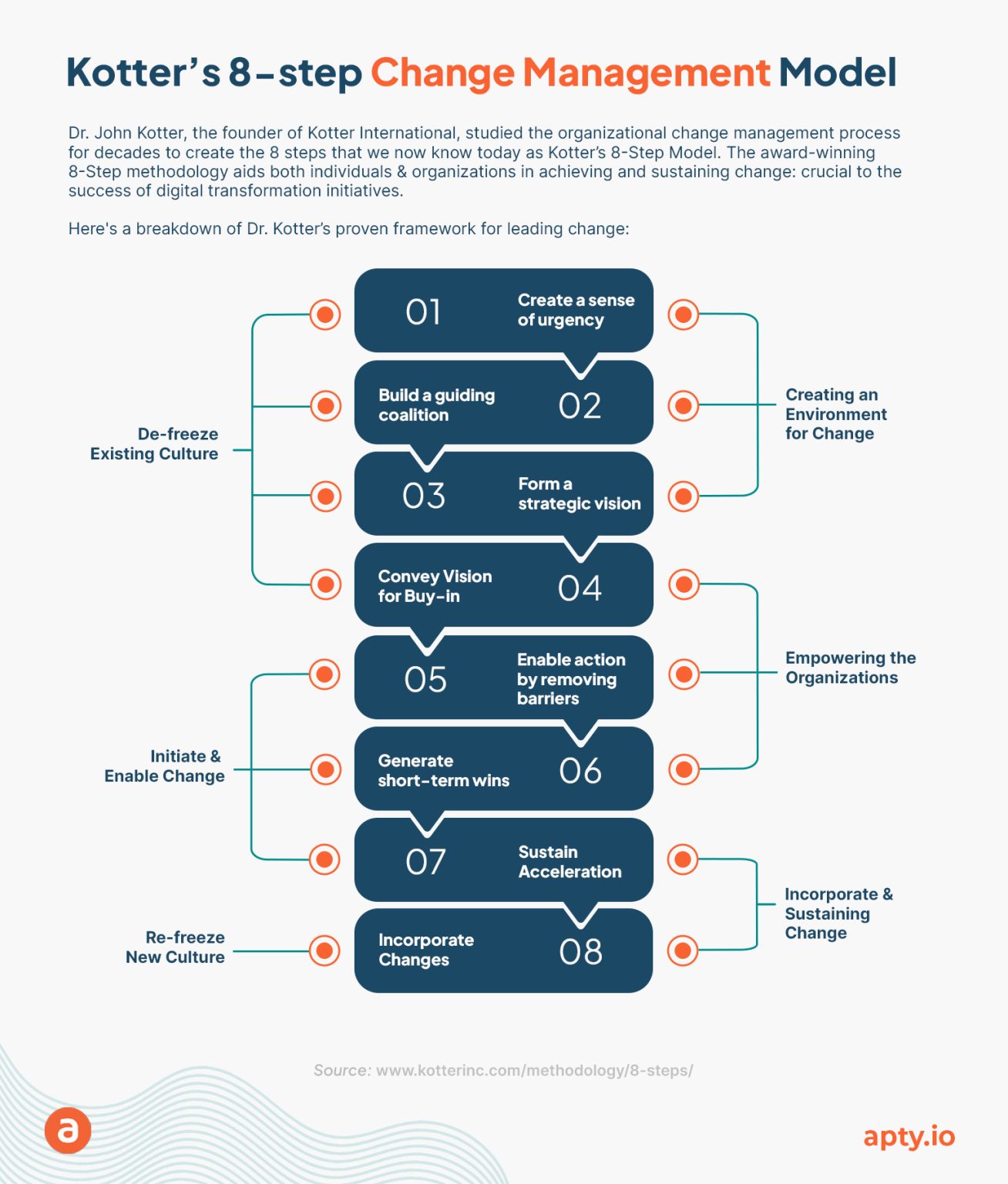Organizational Transformation is often met with resistance and the implementation of changes is an intimidating prospect. However, adaptation is essential for sustainable business.
According to a research by Harvard Business Review, more than 60% of all organizational change initiatives fail. Many companies struggle with handling issues related to transformation and quick adoption.
Change Management, when executed effectively, can act as a differentiator as well as guide employees to adapt to the new processes faster and better.
John Kotter, the founder of Kotter International, broke down the organizational change management process into 8 steps that we now know as Kotter’s 8 Step Model. (More on this later)
For now, let me share an interesting story,
A company called NetApp which is into cloud data services and data management services have applied kotter’s 8 step change model to achieve three strategic goals:
- Grow market share
- Implement global partnerships
- Drive efficiencies
Look at what they have achieved with this strategy.
44% increase in revenue, a 55% increase in sales, as well as $14 BILLION growth in market capitalization. (Source: kotterinc.com)
There are a lot of such success stories, that speak volumes on the importance of Kotter’s change management model, in today’s ever-changing business landscape.
What is Kotter’s 8 Step Change Model?
John Kotter developed the “Kotter’s 8 Step Change Model” to increase every individual ability to change and to improve their chances of success. The 8-steps for successful organizational change management are:
- Establish a sense of urgency
- Form a guiding coalition
- Develop a strategic vision & initiatives
- Convey the vision for buy-in
- Empower others to enact action
- Generate short-term wins
- Sustain acceleration
- Incorporate changes into the culture
Let’s take a detailed look at each of Kotter’s change management model and understand how to make use of it effectively.

1. Establish a sense of urgency
The first step of Kotter’s leading change model is creating a sense of urgency.
If you want a win-win situation, then creating “a sense of urgency” is a powerful way forward. In our case, the sense of urgency is “the need for change”.
The idea is to take everyone out of their comfort zones and make your employees understand the need. Employees of your company must get a feeling that the upcoming transformation is essential and it’s beneficial to them as well as the organization at large.
Our foremost objective in this step is to motivate and develop interest among employees to support this change. For transformation to happen, you need at least 75% of your people to support the initiative.
Here are a few steps that you can follow for a smooth process:
- Before suggesting the need, discuss the current problem with your team, and try to get their opinions.
- Post that, address all their concerns on whether that will work or not.
- Now your employees have clearly understood that there is a problem in the organization and you are trying to solve.
- Go ahead and create a sense of urgency
- Be open-minded with your employees and provide some authentic statistics which adds value to the need for change statement.
By following these steps, you will be able to catch your employees’ interest towards the initiative. Also, here are some things that you can do in step d.
- Request support from stakeholders, market leaders, and your customers to support your statement
- Give dynamic and convincing reasons to catch the attention
- Strengthen your standing by showcasing the right examples
Note: For successful implementation, you need employee support. So spend an ample amount of time building urgency and then proceed to step 2.
2. Form a guiding coalition
The second aspect of Kotter’s 8 steps model is to form a team that has completely understood the need. It’s very difficult for an individual to manage the entire process. Therefore, you need a coalition of effective individuals.
This coalition will help to manage and encourage your employees to “buy-in” and aid the transformation process.
3 steps that you need to follow for building a coalition:
- Identify the people who are showing interest in the process.
- Select a leader who has a wide range of skills and experience. With the help of a leader, form a coalition that will encourage all other employees who are not willing to transform. (By doing so you can get support from different areas within the organization)
- The coalition must be consist of individuals across working in different functions and positions of the organization so that all employees can rely on the group.
The process cannot be led by a single person – so form a coalition by following the above-stated steps which will guide your employees forward in the process.
The checklist that you need to keep in mind:
- Identify the real leaders
- Allocate roles and responsibilities for change leaders
- Analyze risks and challenges associated with the change
- Have frequent performance measures
- Include diversity in change coalition
Note: Your objective is to select a few effective leaders and delegate multiple roles and responsibilities to them.
3. Develop a strategic vision & initiatives
The purpose of this step in Kotter’s 8-step model is to create a sensible vision. A clear and achievable vision can help people understand why you’re asking them to change.
The initiative is likely to be complicated and often difficult to understand. For this reason, you need to create a vision that is clear, easy yet understandable for all levels of employee
Steps to create a clear vision:
- Start thinking about “how” – there will be many great ideas and solutions floating around.
- Pick out the ideas that are more beneficial, exciting, and appealing.
- Link all these concepts to an overall vision in a way that every individual of your organization can grasp easily and remember.
- Then go ahead and clarify how the future will be different from the past.
By following these steps you will be able to create a clear vision and also make sure you are open to receiving feedback and queries at every step.
Few tips that might help you in creating a vision:
- Think outside the box
- Establish a common goal within the organization
- Take every feedback into consideration
- Actively respond to doubts & questions
- See from an employee’s perspective
Note: When employees understand what you’re trying to achieve, then your directives will have maximum effect.
4. Convey the vision for buy-in
Once if you have a clearly defined the vision, the action part comes in. In this phase of applying Kotter’s 8 step change model, you need to communicate the vision. For higher effectiveness, you must repeat your vision statement at every chance you get.
Only by effectively communicating the vision and the initiatives will you get your employees to accept and support the change initiative. The change leaders must leverage every opportunity to discuss the vision with employees and encourage cooperation & support.
You can see a large-scale change only when a majority of your employees rally around your vision (common goal). A few points that you must remember, in order to grasp the majority of people’s attention while communicating the vision, are:
- Walk the talk – what you do matters a lot than what you say
- Enlist a volunteer army to support the vision
- Communicate positively and consistently
- Spread vision and build buy-in from all employee levels
- Understand employee concerns and minimize employee resistance
Note: Our aim is to capture the hearts and minds of your employees and inspire them to support the transformation.
5. Empower others to enact action
Coming to the 5th step of Kotter’s 8-step model, where you need to empower others by primarily removing obstacles. When executing organization-wide change, you might encounter obstacles frequently.
The leader and the guiding coalition should remove any such obstacles that are blocking your organization’s journey towards success.
Steps to make this happen:
- Before hopping into removing, you must jot down all the obstacles & barriers from the employee perspective.
- To have a clear understanding of each obstacle, segregate them like individuals, physical, traditions, or legislation obstacles.
- Know the barriers that hinder the organizational transformation process and address it at the earliest.
- Empower employees by providing necessary training & mentoring.
- Leverage Digital Adoption Platform for effective training – training using interactive walkthroughs.
Follow these steps to empower your employees and there are some tips that you can use to make this process smooth.
- Openly communicate with employees to identify the barriers.
- Identify the obstacles that are the most resistant to your revolution and resolve them
- Bring in industry leaders to deliver the change
- Provide rewards to employees who actively work on implementing transformation
Incorporating pre-employment testing in your recruitment process can improve the candidate experience.
Note: Removing hierarchies and barriers in the transformation process provides the necessary freedom to work across silos and generate real impact.
6. Generate short-term wins
In the 6th step of Kotter’s 8-step model, success is the best motivation. In the process of transformation, give your employees a taste of success at the earliest possible time. This will motivate them and create momentum for your vision.
Ask your change coalition team to focus more on short-term goals rather than long-term. When there is a smaller target, the chances of failure are minimal and by achieving multiple short-term goals, you can ultimately, achieve long-term success.
| Short-term goals | Long-term goals |
| Smaller target | Target seems to be huge |
| Progress can be seen easily & quickly | Irrespective of performance, progress bar moves slow |
| Employees feel comfortable & get motivated | Employees get overwhelmed |
| The pressure is comparatively low | High pressure |
| Short-term success brings happiness | Taste of success takes a long time |
| Milestones at a quickly achievable distance | Spread out milestones, demotivating employees |
Now that we have seen the importance of generating short-term wins, here are a few tips to create short-term wins:
- Set feasible short-term goals
- Consider all aspects of the pros & cons of the short-term target (failing at the early target demotivates your employees)
- Focus on sure-hit targets
- Continuously communicate and reward success
- Energize volunteers to persist
Note: Short-term victories are the best motivation to achieve success in transformation and also a great way to combat any critics of your vision.
7. Sustain Acceleration
Kotter’s 7th step is all about sustaining the acceleration of your vision.
Two big mistakes that many organizations make are:
- Getting overwhelmed with quick wins (short-term)
- Seeking immediate progress in long-term goals
If you are one among them, your change trajectory will never hit the target.
Change is a slow and ongoing process. To continuously enjoy the benefits, ingrain change in your organization’s values, objectives, and culture. Kotter argues that after the initial success, you must push the pedal harder to keep the momentum going. So, it is essential to sustain the change for long after implementation.
Tips to sustain the acceleration:
- Keep setting goals and monitor the progress frequently. Achieving many short-term wins accelerates your long-term vision
- Ensure that your change leaders and guiding coalition teamwork persistently towards achieving organizational change
- Increasing credibility will improve organizational structure & systems
- Analyze what went wrong and what was right soon after each success or failure
- Keep looking for improvements
- Make use of industrial influencers or stakeholders to discuss the need for transformation
Note: Our objective is to sustain the transformation by anchoring the changes in corporate culture. You must continuously make improvements (Kaizen) which ensures the momentum of change.
8. Incorporate changes into the culture
Ideas to incorporate changes into the culture,
By simply changing employees habits you cannot instill a cultural change across the organization. To have a lasting effect, you must anchor and truly embed the changes within the core of your organization.
Change leaders and guiding coalition team are responsible for embedding the cultural transformation among all members and alter their behaviors to support & participate in the initiative.
Ideas to incorporate changes into the culture,
- Ingrain the change into the company culture
- Communicate the change with the entire organization
- Connect the change with performance results
- Create a workout plan & stick to it
- Integrate improvements into the process
- Be open to suggestions & ideas
Note: Change will not do anything by itself. You must take the initiative to institute permanent organization-wide transformation.
Final Thoughts
Kotter’s 8 step-model is a people-focused, structured approach that helps companies to diffuse employee resistance – the most common barrier that delays the Digital Transformation process.
Nevertheless, without considering employee feedback, Kotter’s 8-step model is risky. To make this top-down approach a successful model, pair it with a Digital Adoption Platform, like Apty, that helps keep the doors of employee feedback open throughout the process.
Since you have reached this far, we presume that you are looking for a change management model and other digital tools to ensure successful digital transformation.
If so, you might want to take this into consideration. Apty is the highest-rated Digital Adoption Platform that goes with any change management model. Our product tells you where your employees struggle and also gets your employee feedback instantaneously.
Table of Contents
- What is Kotter’s 8 Step Change Model?
- 1. Establish a sense of urgency
- 2. Form a guiding coalition
- 3. Develop a strategic vision & initiatives
- 4. Convey the vision for buy-in
- 5. Empower others to enact action
- 6. Generate short-term wins
- 7. Sustain Acceleration
- 8. Incorporate changes into the culture
- Accelerate Organizational Change Management with Apty
- Oracle HCM Implementation: Steps & Best Practices 2025
- ERP Implementation: Steps, Challenges & Best Practices
- 9 Change Management Strategies for Smooth Transitions






